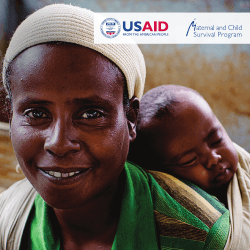
Enabling Ultrasound in Remote Maternal & Child Health
Enabling Ultrasound in Remote Maternal & Child Health Remote Maternal & Child Health • World-wide about 80% of maternal deaths are due to pregnancy-related complications (0.5M deaths per year) • 99% of these are in developing countries • Remote areas have particularly high incident rates • Nepal has one of the highest mortality rates at 740 per 100,000 births • In Nepal 4,500 mothers die annually • In remote areas maternal death has huge social and economic consequences since mothers are the backbone of rural societies Ultrasound to Monitor Pregnancy • Well established in the developed world and most hospital settings • Effective in diagnosing potential complications during birth (e.g. obstructed labour caused by malpresentation, cephalo-pelvic disproportion) • Requirements are: • Low cost, easy to use, high tech equipment • Trained ultrasound technologists and access to radiologists • These are absent in remote settings Ultrasound in Remote Maternal & Child Health • Portable ultrasound equipment is commercially available at a cost of $5,000 - $7,000 per unit Ultrasound in Remote Maternal & Child Health • Portable ultrasound • Train field technologists by partnering with local NGO “Himalayan Health Care” • constructed and funds a community hospital in Ilam, serving a region of 300k people • treks to remote villages with volunteer doctors Ultrasound in Remote Maternal & Child Health • Portable ultrasound • Train field technologists • Communication between field workers/technologists and hospital setting • Capture and transfer of images via smart-phone • Management of images () • User and workflow management () Patient Field technologists Wireless station in Nangi, Nepal Server Radiologist Project Status • October 2011: Established link to NGO in Nepal • June 2012: Built Android App to capture image and transmit to server – this project won 1st place at June 2012 Toronto Random Hacks of Kindness (RHoK) • June 2012: Presented project to SickKids International & SickKids Foundation • Oct – Dec 2013: Two computer science student teams from University of Toronto worked on Android app and server system 2012 RHoK Nepal Ultrasound Team Next Steps • Exploring remote communities in Africa, India, Nunavut, and other resource-poor regions • Project Fundraising: • Manufacturer donations for ultrasound hardware • Finalize and refine IT solution • Funding for pilot hands-on training mission in remote communities Project Needs • Study of cellular network coverage in developing world – intersection of (1) data coverage that allows transmission of images, (2) high maternal mortality, and (3) travel/operational security • Look at individual countries (e.g. India (17%), Nigeria (14%), Sub-Saharan Africa (62%), Afghanistan, Nepal, Haiti, *) • Look at key regions within (developed) countries (e.g. Nunavut) • Scan of NGOs as partners in emerging countries • Scan of funding sources * WHO – Trends in maternal mortality 2013 Contact • Klaus Fiebig, PhD – entrepreneur with extensive biotech and fundraising experience klausfiebig@gmail.com www.kmfbio.ca • Leanne Tran, JD, MD – expert working at the interface of law, medicine, community advocacy, and research leanne.e.tran@gmail.com
© Copyright 2025












